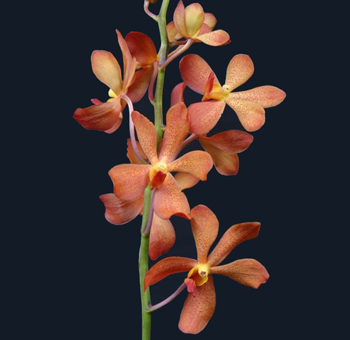
Mokara orchids are inter-generic hybrids of arachnis X ascocentrum X vanda which have many colors compared to other orchids, including purple, pink, blue, red, orange, yellow and coral. And each color also has its own range.
The purple color for instance, could be associated with spirituality and nobility. The deep purple communicates riches, while the light purple or lavender purple of Mokaras reflects delicacy and sweet romance. In some countries like Thailand and China purple is the expression of grief and sadness. While in many cultures purple is the symbol color of sovereigns.
Mokara, commonly named by the Smile Orchid, is native to Asia where it was first discovered and cultivated. This tropical orchid can be found in all continents except for extreme cold regions such as Antarctica. The Sanskrit name Mokara derives from a Hindu philosophy stating that every individual possesses three states of well being which are the causal body, the astral body, and the physical body, where Mokara represents the physical body or the state of form.
Mokara orchids possess a long stem which can produce 10 flowers per stem. Due to their delicacy and bright colors with its striking form of a starfish, Mokaras are popular in wedding bouquets. You can cut the long stem when it is in bloom and put them in a vase of water. To prolong their decorative life, you can re-cut the underwater stem by ¼ inch every 3 days and also replace the water in the vase with lukewarm water.
Mokara orchids are included in the bright light orchid group. Placing it in a spot with morning sunlight until noon will be most sufficient in terms of lighting. If there is any doubt about it receiving enough light, just watch the color of the leaves. Generally healthy orchid leaves are bright green rather than dark green which indicates an insufficiency of light. If the leaves turn to a reddish green, this is a clear indication of it is receiving too much light. The Mokara can tolerate full sun but avoid exposing it to direct sunlight since their leaves have flattened surfaces which tend to absorb more heat that can eventually burn the leaves.
It has been proven that Mokara, especially the modern hybrids, can tolerate low light while showing good health and successful flowering. But if you alter the light intensity, it should be done by slowly moving the orchid from bright light to low light providing it with a time for adaptation. Changing the light intensity too quickly can cause the orchid to struggle and even die. If you wish to care for this orchid in low light intensity, then reduce the frequency of watering and fertilizing.
The most suitable temperature for a Mokara is between 50º – 100ºF. They are strong feeders especially when they are in full growth and should be fertilized once a week spring to fall with watering in between. Fertilizing them once a month throughout fall and winter is sufficient.
Related Articles & Free Email Newsletter Sign Up
How Much Light Does an Orchid Need?
Orchid Growing Tips for Beginners




Comment here